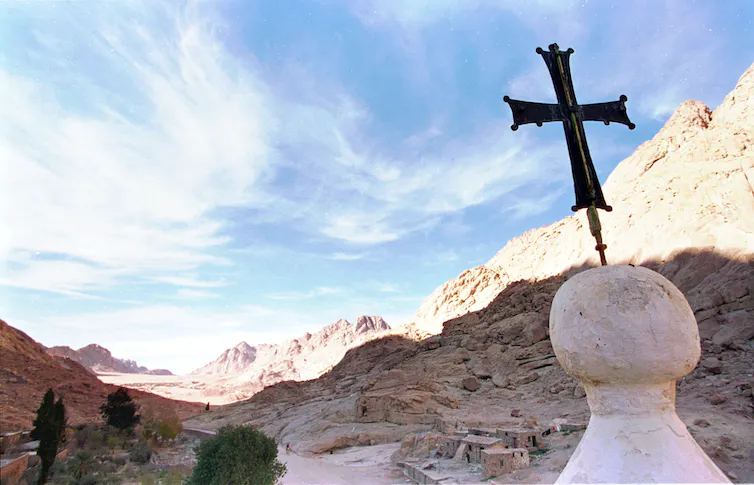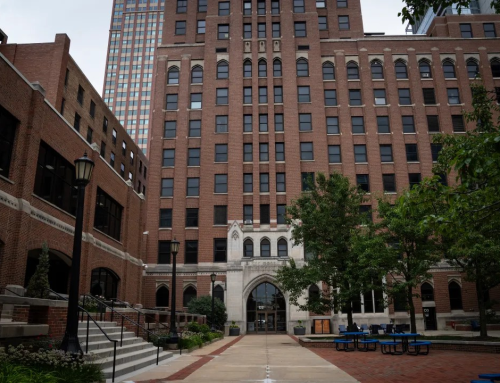– Jacob F. Love | Lecturer in Religious Studies, University of Tennessee
Since Saudi Arabia relaxed rules and expanded visas for tourists in 2019, Christians have been increasingly visiting the country, drawn by word of mouth and promotional YouTube videos, in search of Mount Sinai, where the Bible recounts God revealing the Ten Commandments to Moses.
For many centuries people have believed the location to be in Egypt’s Sinai Peninsula, near the site of a monastery built around 550 C.E. and named after St. Catherine.
But this was entirely based on the word of local tribes living some 2,000 years after the event. Most scholars believe that the location of Mount Sinai is unknowable from the available textual evidence. As a scholar of the Hebrew Bible and language, I agree with them.
The existence of Mount Sinai is likely a legendary myth that is part of the stories of many cultures. There is no corroborating evidence, archaeological or otherwise, to support any particular location.
What’s in a name?
The first biblical mention of the holy mountain occurs in Exodus, the second book of the Bible and the primary source for the story of Moses leading the Israelites out of Egypt.
In Exodus 3:1, a mountain is referred to as Horeb and called the “mountain of God.” Horeb is mentioned twice more in Exodus but then disappears without mention in the third and fourth books – Leviticus and Numbers – until it reappears in the last book of the first section of the Bible, or the Pentateuch – Deuteronomy.
Deuteronomy retells the history of Israel as the Israelites were poised to enter the Holy Land. Throughout Deuteronomy, there are over a dozen references to Horeb as the place where Moses received the commandments.
Horeb is also found in biblical books after the Pentateuch. For example, the prophet Malachi says in the book that bears his name, “Remember the statutes of Moses … whom I commanded at Horeb.”
Horeb is a common name for the mountain in the Bible and yet is far less known than Sinai. The name Sinai is used throughout Exodus and occurs in Leviticus and Numbers, although Horeb is absent from those works.
But in Deuteronomy, Sinai all but disappears – it is used just once in a poem quoted by the author of Deuteronomy (33:2). The poem is cast as Moses’ final benediction of the people and begins, “This is the blessing with which Moses the man of God blessed the children of Israel before his death. He said, ‘The Lord came from Sinai, and dawned from Se′ir upon us; he shone forth from Mount Paran, he came from the ten thousands of holy ones, with flaming fire at his right hand.’”
Horeb or Sinai?
It is not simply a matter of two different names for the same place. That could be explained as easily as noting that Jerusalem is also called the City of David. And it would be logical if the various books scattered these names as if they were interchangeable. But I would argue that the distribution is anything but random.
The references to Sinai are concentrated in Exodus, Leviticus and Numbers, while Deuteronomy refers almost exclusively to Horeb. In other words, the author or authors of Exodus, Leviticus and Numbers strongly preferred the word Sinai while the author of Deuteronomy used only Horeb.
For over 200 years biblical scholars have been analyzing the Pentateuch to discern its editorial history. The result of this search for the authors of the Pentateuch has led to the conclusions that the first four books were written by at least three authors and redacted by editors to combine their stories.
There is evidence to show that the last book, Deuteronomy, was written by a single author. However, scholars argue, an editor probably changed and added material. It is likely that the one poem that mentions Sinai in Deuteronomy, when every other mention of that mountain is in Horeb, is a result of the editorial changes.
A second possibility is that they are two different locations, each of which had sacred status to a particular group of Israelites. The third possibility, favored by most biblical scholars, is that the ancient stories cataloged among the Israelites came from different sources and were ultimately reconciled by editors.
The second and third possibilities are not necessarily mutually exclusive – in other words, even if the stories were written by different authors, those different authors could have the same place in mind.
Perhaps the key fact to keep in mind is that scholars know very little about the location of Mount Sinai and whether or not it is the same place as Horeb.
A strange absence
Many of the books recounting the early history of biblical times, especially the prophets, however, have practically no reference to Sinai or Horeb. Among the 150 Psalms there is but one reference to Sinai.
How can it be that such a critical source of the religion of Israel was of little interest to these prophets? The commandments that Moses is believed to have received from God framed the lives of all Israelites and established the priestly offerings, the courts, and the rules for marriage, divorce and inheritance. Yet, none of the prophets felt a need to call upon Israel to follow the laws of Moses given at Sinai or Horeb. Is it not more reasonable to imagine that they simply knew little of those events or did not attach much importance to them?
Some people might conclude that the belief about Moses at Sinai is just invention. After all, there is so much historical and archaeological evidence for the history of places such as Jerusalem and Lachish. But in the case of Horeb or Sinai, the geographical hints found in the Bible are insufficient to make any sort of determination.
In other words, there isn’t sufficient data to decide whether the biblical account of Sinai or Horeb happened somewhere, or whether it is perhaps a foundation legend created for some purpose such as uniting the disparate Hebrew-speaking tribes of Israel.
When some Christians, such as the ones now looking for Sinai in Saudi Arabia, examine these sources, they often try to stitch together texts written over centuries after the events supposedly happened. It is not surprising that various people have assigned the location of Sinai to locations hundreds of miles apart.
Based on all the evidence – or lack thereof – I argue that Sinai is located not in any specific place but rather in the hearts and minds of those who treasure the meaning of the Hebrew Bible.
Editor’s note: This article has been updated in order to correct information about St. Catherine’s Monastery.
Original Article – Tourists search for Mount Sinai in Saudi Arabia – but does a geographical location for pivotal Bible event even exist? (theconversation.com)







